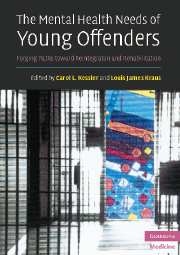Book contents
- Frontmatter
- Contents
- List of contributors
- Foreword
- Acknowledgments
- 1 An overview of child and adolescent mental health needs in the juvenile justice system
- 2 Psychiatric disorders of youth in detention
- 3 Disproportionate minority confinement
- 4 Police interrogation of youth
- 5 Assessing children's competence to stand trial and to waive Miranda rights: new directions for legal and medical decision-making in juvenile courts
- 6 The etiology of antisocial behavior: biopsychosocial risk factors across development
- 7 Substance abuse in youth offenders
- 8 Suicide and delinquent adolescents
- 9 Juvenile sex offenders
- 10 Educational needs of youth in the juvenile justice system
- 11 Science and the juvenile death penalty
- 12 Medical issues regarding incarcerated adolescents
- 13 Mental health screening and assessment in juvenile justice
- 14 Psychological testing in juvenile justice settings
- 15 Psychopharmacology and juvenile delinquency
- 16 Evidence-based treatment for justice-involved youth
- 17 Community alternatives to incarceration
- 18 Innovative problem-solving court models for justice-involved youth
- 19 Ethical issues of youthful offenders: confidentiality; right to receive and to refuse treatment; seclusion and restraint
- 20 Post-adjudicatory assessment of youth
- Index
- References
10 - Educational needs of youth in the juvenile justice system
Published online by Cambridge University Press: 11 August 2009
- Frontmatter
- Contents
- List of contributors
- Foreword
- Acknowledgments
- 1 An overview of child and adolescent mental health needs in the juvenile justice system
- 2 Psychiatric disorders of youth in detention
- 3 Disproportionate minority confinement
- 4 Police interrogation of youth
- 5 Assessing children's competence to stand trial and to waive Miranda rights: new directions for legal and medical decision-making in juvenile courts
- 6 The etiology of antisocial behavior: biopsychosocial risk factors across development
- 7 Substance abuse in youth offenders
- 8 Suicide and delinquent adolescents
- 9 Juvenile sex offenders
- 10 Educational needs of youth in the juvenile justice system
- 11 Science and the juvenile death penalty
- 12 Medical issues regarding incarcerated adolescents
- 13 Mental health screening and assessment in juvenile justice
- 14 Psychological testing in juvenile justice settings
- 15 Psychopharmacology and juvenile delinquency
- 16 Evidence-based treatment for justice-involved youth
- 17 Community alternatives to incarceration
- 18 Innovative problem-solving court models for justice-involved youth
- 19 Ethical issues of youthful offenders: confidentiality; right to receive and to refuse treatment; seclusion and restraint
- 20 Post-adjudicatory assessment of youth
- Index
- References
Summary
Introduction and overview
In 1998, more than 70 million people (26 percent of the total resident population) in the United States were classified as juveniles, that is, persons less than 18 years of age. The juvenile population fell to its lowest in 1984, but since that time has been growing gradually. It is estimated that, between now and 2015, the number of juveniles in the United States will increase by approximately eight percent. The number of juveniles ages 15–17, the age group responsible for two-thirds of all juvenile arrests, is in fact expected to have increased by approximately 19 percent by the year 2007 (this figure represents the total increase in this particular population between the years 1995–2007). Because public perceptions of juvenile delinquency have been influenced by the increasing media attention focused on high-profile incidents, some speculate that the incidence of juvenile crimes will increase alongside this projected increase in the general juvenile population.
But do the relatively few high-profile cases accurately reflect the majority of crimes actually committed by juveniles? According to the Office of Juvenile Justice and Delinquency Prevention Program (OJJDP), 2.2 million juveniles were arrested in the United States in 2003, which represents a decrease of 11 percent from 1999 (Snyder & Sickmund, 2006). The Juvenile Residential Facility Census, 2002, indicates an even higher rate of decrease in the number of juvenile arrests nationwide, citing a 29 percent decrease since 1996 (OJJDP, 2006).
Keywords
- Type
- Chapter
- Information
- The Mental Health Needs of Young OffendersForging Paths toward Reintegration and Rehabilitation, pp. 229 - 240Publisher: Cambridge University PressPrint publication year: 2007
References
- 2
- Cited by



